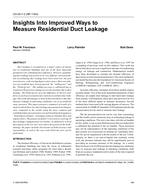Description
Duct leakage is recognized as a major source of energy loss in residential buildings and one of the most important parameters for estimating duct efficiency. However, quantifying duct leakage has proven to be very difficult. Several methods of estimating duct leakage have been used over the past several years, with varying degrees of accuracy. More recently, two new methods have been proposed: the “nulling test†and the “Delta-Q test.†The nulling test uses a calibrated fan to counteract the pressure change across the envelope due to duct leakage. The Delta-Q test uses the difference in blower door flows at each of several pressure stations to estimate duct leakage. One of the advantages to both of these methods is that they measure leakage at operating conditions, not at an artificial static pressure. This paper presents a summary of results of a study in which these new duct leakage measurement techniques were compared to the results using the more common and established fan pressurization test and benchmarked against a “benchmark estimate†of leakage using air-handler flow and register flows. The project included 73 sets of tests covering 26 duct leakage configurations in 9 homes. In addition to a brief description of the two new tests and a discussion of the methodology, the paper includes discussions of both accuracy and repeatability, as well as the ease with which the tests can be performed.
Units: Dual
Citation: Symposium, ASHRAE Transactions, vol. 109, pt. 1
Product Details
- Published:
- 2003
- Number of Pages:
- 11
- File Size:
- 1 file , 210 KB
- Product Code(s):
- D-16820




